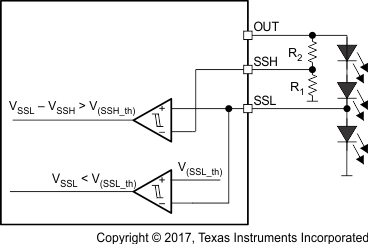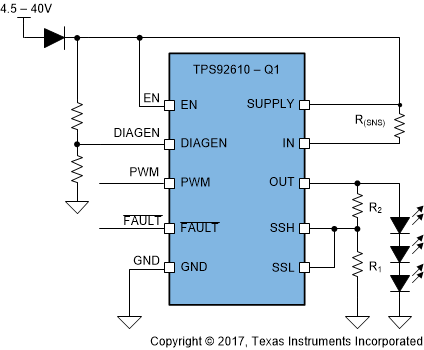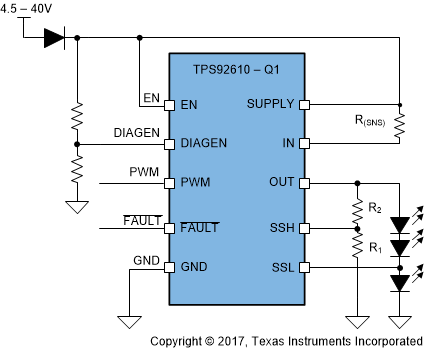ZHCSH65B October 2017 – January 2020 TPS92610-Q1
PRODUCTION DATA.
- 1 特性
- 2 应用
- 3 说明
- 4 修订历史记录
- 5 Pin Configuration and Functions
- 6 Specifications
- 7 Detailed Description
- 8 Application and Implementation
- 9 Layout
- 10器件和文档支持
- 11机械、封装和可订购信息
7.3.5.5 Single-LED-Short Detection
The TPS92610-Q1 device supports single-LED-short detection by using the SSH and SSL pins. In case there is no need of this feature, SSH and SSL must be tied together to a resistor divider to avoid false alarms as shown in Figure 21.
The TPS92610-Q1 device has integrated a precision comparator to monitor a single-LED-short failure. The comparator uses the bottom LED forward voltage V(SSL) as a reference and monitors the string voltage V(OUT) with resistor divider R1 and R2 at V(SSH).
If a single-LED short is detected, the device turns off the output channel and retries with a small current I(RETRY). Once the fault is removed, the device automatically resumes normal operation.
 Figure 20. Single-LED Short Detection
Figure 20. Single-LED Short Detection Use the following equation to calculate the ratio of R1 and R2.

By using the resistor divider with values calculated in Equation 2, the voltages of SSH and SSL are then equal to the forward voltage of a single LED. With built-in comparators, the device can report failure if any of the LEDs is shorted within this string.
An internal resistor string on SSL and resistors R1 and R2 draw current from OUT. TI recommends total resistance of R1 and R2 greater than 100-kΩ, so the current has negligible effect on LED luminance.
Even within the same batch of LEDs, the LED forward voltage may vary from one to another. Taking account of forward voltage differences is necessary to avoid any false faults.
 Figure 21. Bypass Single-LED Short Detection
Figure 21. Bypass Single-LED Short Detection  Figure 22. With Single-LED Short Detection
Figure 22. With Single-LED Short Detection